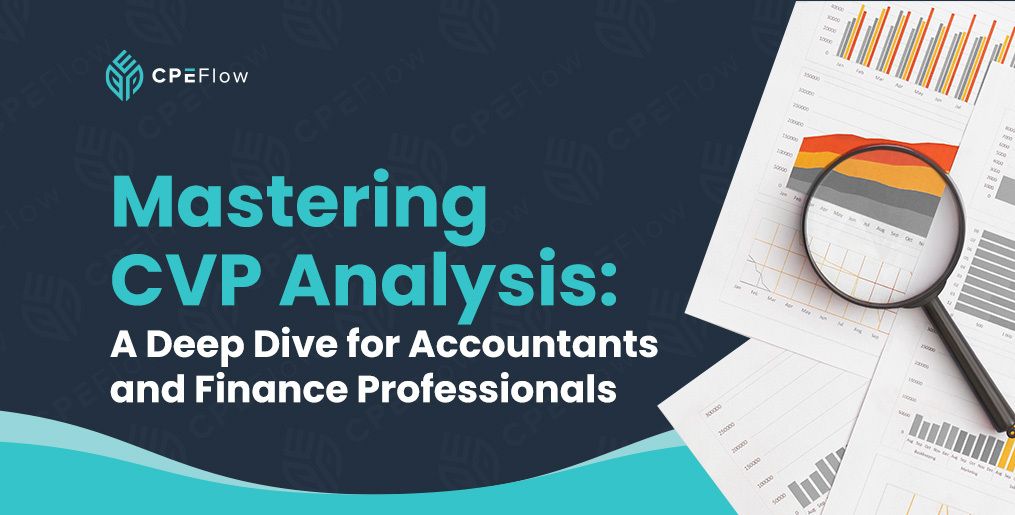Cost-volume-profit (CVP) analysis is essential in the accountant's toolkit. This powerful methodology examines the relationship between costs, volume, and profit to provide pivotal insights for business decision-making.
Sound intimidating? It’s a relatively straightforward framework providing insights into a company’s profit drivers and breakeven points. Mastery of CVP techniques empowers accountants to make more intelligent recommendations around production levels, pricing, introduction of new products, and more.
In this post, I’ll cover the fundamentals of constructing and applying CVP analysis models so you can maximize the value of this technique. Whether you’re new to CVP or looking to level up your skills, this deep dive has everything you need to master cost-volume-profit analysis.
Equipped with CVP chops, you can enhance your value to any organization by uncovering profit drivers, spotlighting break-even points, and enabling data-backed decisions. Let’s get started!
CVP stands for cost-volume-profit.
CVP analysis is a modeling approach that estimates how changes in costs and volume affect a company's profitability.
CVP examines the following key components:
• Total Revenue: Revenue generated from unit sales
• Variable costs: Expenses that change in proportion to volume
• Fixed costs: Expenses that remain constant despite changes in volume
• Contribution margin: Revenue less variable costs
• Break-even point: The volume where total revenue equals total costs
Understanding the behavior of each component is crucial for developing and interpreting an insightful CVP model.
CVP empowers managers to make smarter decisions about prices, production levels, costs, product mix, and new product launches. Key benefits of CVP analysis include:
• Determine break-even volume to operate profitably
• Evaluate profitability at different sales levels
• Reveal profit drivers and optimize sales mix
• Model impact of cost changes on the bottom line
• Inform strategic decisions around pricing, expansion, and new product introductions
Without CVP analysis, it’s impossible to understand the relationships between key business drivers fully. CVP highlights these connections.
Get Exclusive Access & Special Discounts!
Get early bird access to new CPE courses and exclusive discounts only shared with our email subscribers.
Constructing a CVP model starts by identifying assumptions for each component:
Revenue: Price per unit multiplied by volume. e.g. $100 price * 10,000 units = $1,000,000 revenue
Variable costs: The variable cost per unit multiplied by volume. e.g. $50 variable cost per unit * 10,000 units = $500,000 variable costs
Fixed costs: Costs that don’t fluctuate based on volume. e.g. $100,000 rent expense.
Contribution margin: Revenue less variable costs. e.g. $1,000,000 revenue - $500,000 variable costs = $500,000 contribution margin
Break-even point: Where total revenue equals total costs. This is calculated by dividing fixed costs by the contribution margin per unit.
Understanding how each of these components behaves is the foundation of CVP analysis.
Let's walk through
constructing a CVP model using sample assumptions. After all, there’s no better way to learn than doing.
Selling price per unit: $100
Variable cost per unit: $60
Fixed costs: $300,000
Volume: Let's evaluate outcomes at 5,000 units and 10,000 units
First, calculate revenue and variable costs at each volume using the above per-unit assumptions.
At 5,000 units:
Revenue = $100 per unit x 5,000 units = $500,000
Variable costs = $60 per unit x 5,000 units = $300,000
At 10,000 units:
Revenue = $100 per unit x 10,000 units = $1,000,000
Variable costs = $60 per unit x 10,000 units = $600,000
Next, determine the contribution margin per unit by subtracting the variable cost per unit from the selling price:
Contribution margin per unit = $100 - $60 = $40
Now, we can calculate the break-even point by dividing the fixed costs of $300,000 by the contribution margin per unit of $40, which equals 7,500 units.
Finally, we can calculate profit at each volume above the break-even point of 7,500 units.
At 5,000 units:
Revenue = $500,000
Variable costs = $300,000
Contribution margin = $200,000
Fixed costs = $300,000
Profit = -$100,000
At 10,000 units:
Revenue = $1,000,000
Variable costs = $600,000
Contribution margin = $400,000
Fixed costs = $300,000
Profit = $100,000
This example demonstrates how CVP analysis uncovers the volume required to break even and the profit at different sales levels. The model can easily be adjusted to evaluate different pricing, cost, and volume scenarios.
CVP clearly shows the impact price changes have on profitability. For example, decreasing per-unit pricing may drive increased volumes, but overall profit could suffer if the contribution margin decreases. CVP guides optimal pricing strategies.
The break-even and margin of safety outputs from CVP analysis signal whether current production levels are profitable. CVP also indicates how scaling production up or down will affect the bottom line. Management can use these insights to set ideal production targets.
Since CVP analysis highlights the contribution margin, it focuses on maximizing revenues while minimizing variable costs. CVP shows which activities are profit drivers and where costs may be reduced to improve margins. This aids targeted cost control efforts.
Before launching new offerings, CVP analysis can assess potential profitability at various sales levels. This allows management to identify volume requirements and pricing needed to meet profit goals for new product or service introductions.
Constructing models for multiple scenarios (best/worst case, price fluctuations, cost changes, etc.) allows robust evaluation of potential strategic decisions. CVP enables sound "what-if" analysis.
With a CVP model, accountants can determine the precise volume needed at given prices and costs to achieve specific profit objectives. This supports profit-centered planning.
For companies with multiple product lines, CVP guides decisions on an ideal sales mix between varying profit margin products to maximize overall profits.
The wide range of CVP applications demonstrates its power as a planning and decision-making toolkit for accountants.
CVP analysis is a powerful tool for accountants when appropriately used. Key benefits include:
• Highlights break-even volume and profit drivers
• Allows modeling of diverse business scenarios
• Requires only basic data to construct
• Easy to update with new operating assumptions
• Focuses attention on critical sales, cost, and profitability metrics
• Simplifies complex business environments
• Assumes stable linear relationships
• Can't anticipate unexpected market changes
• Provides broad estimates, not precision forecasts
Combining CVP analysis with other techniques helps overcome these challenges and maximize its usability.
CVP analysis is a foundational framework for management accountants making high-impact business recommendations. This post explored the key concepts, calculations, and applications of CVP modeling.
To take your CVP analysis skills to the next level, explore
CPE Flow's engaging continuing education course. You’ll master advanced applications like target profit analysis, sales mix optimization, and sensitivity analysis using CVP models.
CPE Flow is a NASBA-approved learning platform, and our
CVP Analysis course offers 4.5 CPE credits for certified professionals looking to increase their continuing education credits.

Nathan Liao, CMA
Empty space, drag to resize
Nathan Liao, a Certified Management Accountant, educator, and influential business figure in the accounting industry, has dedicated over a decade to supporting more than 82,000 accounting and finance professionals in their pursuit of the CMA certification. As the visionary founder of CMA Exam Academy and CPE Flow, Nathan is committed to delivering premier online training solutions for the next generation of accounting and finance professionals.


